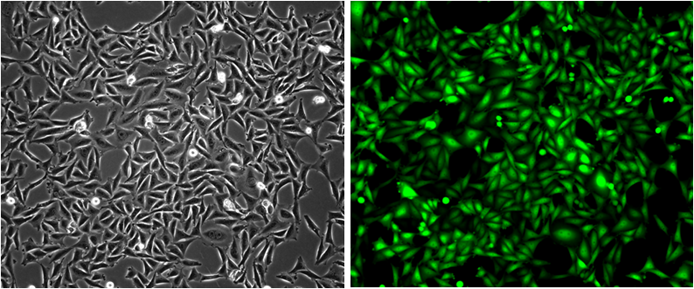Recombinant human NKG2D protein with N-terminal mouse Fc

Figure 1. Human NKG2D Protein, mFc Tag on SDS-PAGE under reducing condition.
Roll over image to zoom in
Shipping Info:
For estimated delivery dates, please contact us at [email protected]
| Amount : | 50 µg |
| Purification : | The purity of the protein is greater than 95% as determined by SDS-PAGE and Coomassie blue staining. |
| Content : | Lyophilized from sterile PBS, pH 7.4. Normally 5 % - 8 % trehalose is added as protectants before lyophilization. |
| Storage condition : | Store at -80°C for 12 months (Avoid repeated freezing and thawing) |
| Alternative Name : | NKG2D,CD314,KLRK1,NK cell receptor D |
Expression Host : HEK293
The protein has a predicted molecular mass of 42.8 kDa after removal of the signal peptide.The apparent molecular mass of NKG2D-mFc is approximately 50-65 kDa due to glycosylation.
Natural killer (NK) cells are lymphocytes that can mediate lysis of certain tumor cells and virus-infected cells without previous activation. They can also regulate specific humoral and cell-mediated immunity. NK cells preferentially express several calcium-dependent (C-type) lectins, which have been implicated in the regulation of NK cell function. The NKG2 gene family is located within the NK complex, a region that contains several C-type lectin genes preferentially expressed in NK cells. This gene encodes a member of the NKG2 family. The encoded transmembrane protein is characterized by a type II membrane orientation (has an extracellular C terminus) and the presence of a C-type lectin domain. It binds to a diverse family of ligands that include MHC class I chain-related A and B proteins and UL-16 binding proteins, where ligand-receptor interactions can result in the activation of NK and T cells. The surface expression of these ligands is important for the recognition of stressed cells by the immune system, and thus this protein and its ligands are therapeutic targets for the treatment of immune diseases and cancers. Read-through transcription exists between this gene and the upstream KLRC4 (killer cell lectin-like receptor subfamily C, member 4) family member in the same cluster.
The protein has a predicted molecular mass of 42.8 kDa after removal of the signal peptide.The apparent molecular mass of NKG2D-mFc is approximately 50-65 kDa due to glycosylation.
Natural killer (NK) cells are lymphocytes that can mediate lysis of certain tumor cells and virus-infected cells without previous activation. They can also regulate specific humoral and cell-mediated immunity. NK cells preferentially express several calcium-dependent (C-type) lectins, which have been implicated in the regulation of NK cell function. The NKG2 gene family is located within the NK complex, a region that contains several C-type lectin genes preferentially expressed in NK cells. This gene encodes a member of the NKG2 family. The encoded transmembrane protein is characterized by a type II membrane orientation (has an extracellular C terminus) and the presence of a C-type lectin domain. It binds to a diverse family of ligands that include MHC class I chain-related A and B proteins and UL-16 binding proteins, where ligand-receptor interactions can result in the activation of NK and T cells. The surface expression of these ligands is important for the recognition of stressed cells by the immune system, and thus this protein and its ligands are therapeutic targets for the treatment of immune diseases and cancers. Read-through transcription exists between this gene and the upstream KLRC4 (killer cell lectin-like receptor subfamily C, member 4) family member in the same cluster.
|
There are currently no product reviews
|


















.png)









